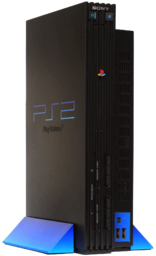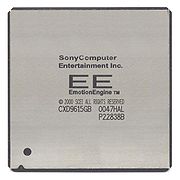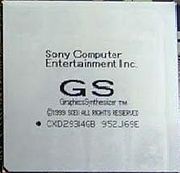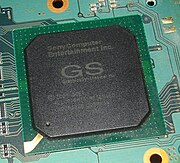PlayStation 2
From Wikipedia, the free encyclopedia
The PlayStation 2 (often shortened to PS2) is a sixth-generation video game console manufactured by Sony. The successor to the PlayStation, and the predecessor to the PlayStation 3, the PlayStation 2 forms part of the PlayStation series of video game consoles. Its development was announced in March 1999 and it was released a year later in Japan. Its primary competitors were Sega's Dreamcast, Microsoft's Xbox, and the Nintendo GameCube.The PS2 is the best-selling console to date, having reached over 138 million units sold as of August 18, 2009 and a software library projected to exceed about 1,900 games in 2009. Several new games are scheduled to be released in 2010, thus continuing the sixth generation. It also holds the dubious record for "First Console in a Nuclear Weapons conspiracy
 | |
|---|---|
 Original model design and logo of the PS2. | |
| Manufacturer | Sony Computer Entertainment |
| Product family | PlayStation |
| Type | Video game console |
| Generation | Sixth generation (128-bit era) |
| Retail availability | JP March 4, 2000 NA October 26, 2000 EU November 24, 2000 AUS November 30, 2000 |
| Units shipped | 138 million (as of September 1, 2009) |
| Media | DVD, CD |
| CPU | 128-bit "Emotion Engine" clocked at 294.912 MHz (launch), 299 MHz (newer models) |
| Storage capacity | 40 GB Hard Drive , PlayStation and PlayStation 2 Memory cards |
| Graphics | "Graphics Synthesizer" clocked at 147.456 MHz |
| Controller input | DualShock 2 |
| Connectivity | 100 Mbit Ethernet/modem adapter, 2x USB 1.1 |
| Online services | Dynamic Network Authentication System |
| Best-selling game | Grand Theft Auto: San Andreas: 17.33 million sold (as of February, 2009) |
| Backward compatibility | PlayStation |
| Predecessor | PlayStation |
| Successor | PlayStation 3 |
History
Only a few million people had obtained consoles by the end of 2000 due to manufacturing delays.Directly after its release, it was difficult to find PS2 units on retailer shelves. Another option was purchasing the console online through auction websites such as eBay, where people paid over one thousand dollars for a PS2. The PS2 initially sold well partly on the basis of the strength of the PlayStation brand and the console's backward compatibility, selling over 980,000 units in Japan by March 5, 2000, one day after launch. This allowed the PS2 to tap the large install base established by the PlayStation — another major selling point over the competition. Later, Sony added new development kits for game developers and more PS2 units for consumers.A notable piece of advertising for the PS2 launch was accompanied by the popular "PS9" television commercial. It was to be the epitome of development, toward which the PS2 was the next step. The ad also presaged the development of the PlayStation Portable (first released in Japan on December 12, 2004).
Many analysts predicted a close three-way matchup between the PS2 and competitors Microsoft's Xbox and the Nintendo GameCube (GameCube being the cheapest of the three consoles and had an open market of games); however, the release of several blockbuster games during the 2001 holiday season maintained sales momentum and held off the PS2's rivals.
Although Sony, unlike Sega with its Dreamcast, placed little emphasis on online gaming during its first years, that changed upon the launch of the online-capable Xbox. Sony released the PlayStation Network Adaptor in late 2002 to compete with Microsoft, with several online first–party titles released alongside it, such as SOCOM: U.S. Navy SEALs to demonstrate its active support for Internet play. Sony also advertised heavily, and its online model had the support of Electronic Arts. Although Sony and Nintendo both started out late, and although both followed a decentralized model of online gaming where the responsibility is up to the developer to provide the servers, Sony's attempt made online gaming a major selling point of the PS2.
In September 2004, in time for the launch of Grand Theft Auto: San Andreas, Sony revealed a new, slimmer PS2 (see Hardware revisions). In preparation for the launch of the new models (SCPH-70000-90000), Sony stopped making the older models (SCPH-30000-50000) to let the distribution channel empty its stock of the units. After an apparent manufacturing issue—Sony reportedly underestimated demand—caused some initial slowdown in producing the new unit caused in part by shortages between the time the old units were cleared out and the new units were ready. The issue was compounded in Britain when a Russian oil tanker became stuck in the Suez Canal, blocking a ship from China carrying PS2s bound for the UK. During one week in November, British sales totalled 6,000 units — compared to 70,000 units a few weeks prior. There were shortages in more than 1700 stores in North America on the day before Christmas.
Sony announced that starting April 1, 2009, the PS2 would be retailing at the price of $99.99.
Hardware and software compatibility
In addition to PS2 software, the PS2 can read both CDs and DVDs and is backward compatible with PlayStation games. The PS2 also supports PlayStation memory cards and controllers, although the memory cards only work with PS1 games and the controllers may not support all functions (such as analog buttons) for PS2 games.The PS2's DualShock 2 controller is essentially an upgraded PlayStation DualShock; analog face, shoulder and D-pad buttons replaced the digital buttons of the original. Like its predecessor, the DualShock 2 controller has force feedback, which is commonly called the "vibration" function. The standard PlayStation 2 memory card has an 8MB capacity and uses Sony's MagicGate encryption. This requirement prevented the production of memory cards by third parties who did not purchase a license for the MagicGate encryption. Memory cards without encryption can be used to store PlayStation game saves, but PlayStation games would be unable to read from or write to the card - such a card could only be used as a backup.
The console also features USB and IEEE 1394 expansion ports. Compatibility with USB and IEEE 1394 devices is dependent on the software supporting the device. For example, the PS2 BIOS will not boot an ISO image from a USB flash drive or operate a USB printer, as the machine's operating system does not include this functionality. By contrast, Gran Turismo 4 is programmed to save screenshots to a USB mass storage device and print images on certain USB printers. A PlayStation 2 HDD can be installed in an expansion bay on the back of the console, with some exceptions (see Hardware revisions below).
Online
With the purchase of a separate unit called the Network Adapter (which is built into the slimline model), some PS2 games support online multiplayer. Instead of having a unified, subscription-based online service like Xbox Live, online multiplayer on the PS2 is split between publishers and run on third-party servers. Most recent PS2 online games have been developed to exclusively support broadband Internet access. Xbox Live similarly requires a broadband Internet connection.All online PS2 games released in and after 2003 are protected by the Dynamic Network Authentication System (DNAS). The purpose of this system is to prevent piracy and online cheating. DNAS will prevent games from being played online if they are determined to be pirated copies or if they have been modified. However, methods have been developed to get around this protection by modifying key files in the modified game.
Also, some unofficial modifications have been made on the PS2 software allowing it to be used as a fully-functional web browser or messenger when connecting to a certain network. The PS2 can also run Linux.
The Playstation 2 Network Adapter fits flush into "Expansion Bay" on the backside of the PS2. The Adapter offers for online play through Broadband internet connections. Also LAN gameplay is accessible through using an ethernet cord, and by connection multiple Playstation 2 consoles together. Online gameplay is also accessible by using a standard Dial-Up online connection with select Playstation 2 game titles.
The broadband adapter allows LAN play with XLink Kai, a created unofficial tunneling software that allows for LAN only games to be played over the Internet.
Hardware revisions
The PS2 has undergone many revisions, some only of internal construction and others involving substantial external changes. These are colloquially known among PS2 hardware hackers as V0, V1, V2, etc., up to V18 (as of 2010).The PS2 is primarily differentiated between models featuring the original case design and "slimline" models, which were introduced at the end of 2004.
Original case design
Three of the original PS2 launch models (SCPH-10000, SCPH-15000, and SCPH-18000) were only sold in Japan, and lacked the expansion bay (Dev9) of current PS2 models. These models included a PCMCIA slot instead of the Dev9 port of newer models. A PCMCIA-to-Dev9 adapter was later made available for these models. SCPH-10000 and SCPH-15000 did not have a built-in DVD movie playback and instead relied on encrypted playback software that was copied to a memory card from an included CD-ROM. (Normally, the PS2 will only execute encrypted software from its memory card, but see PS2 Independence Exploit.) V3 had a substantially different internal structure from the subsequent revisions, featuring several interconnected printed circuit boards. As of V4 everything was unified into one board, except the power supply. V5 introduced minor internal changes, and the only difference between V6 (sometimes called V5.1) and V5 is the orientation of the Power/Reset switch board connector, which was reversed to prevent the use of no-solder modchips. V7 and V8 included only minor revisions to V6. Assembly of the PS2 moved to the People's Republic of China during the development of V9 (model numbers SCPH-50000 and SCPH-50001). The upgraded console added an infrared port for the optional DVD remote control, removed the IEEE 1394 port, added the capability to read DVD-RW and DVD+RW discs, added progressive-scan output of DVD movies, and added a quieter fan. V10 and V11 were only minor revisions to V9.The PS2 standard color is matte black. Several different variations in color have been produced in different quantities and regions, including ceramic white, light yellow, metallic blue (aqua), metallic silver, navy (star blue), opaque blue (astral blue), opaque black (midnight black), pearl white, Sakura purple, satin gold, satin silver, snow white, super red, transparent blue (ocean blue) and also Limited Edition color Pink which was distributed in some regions such as Oceania, and parts of Asia.
The small PlayStation logo on the front of the disc tray could be rotated ninety degrees, in order for the logo to be the right way up in both vertical and horizontal console orientations. This feature is also used in the slimlines.
Slimline
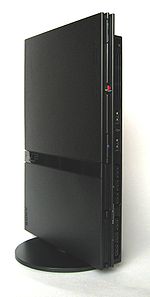 The first PS2 slimline. This was succeeded by another slimline in 2007. | |
| Manufacturer | Sony Computer Entertainment |
|---|---|
| Product family | PlayStation |
| Type | Video game console |
| Generation | Sixth generation era |
| Retail availability | October 2004 - Present |
| CPU | 333 MHz |
| Controller input | DualShock 2 |
There are some disputes on the numbering for this PS2 version, since there are actually two sub-versions of the SCPH-70000. One of them includes the old EE and GS chips, and the other contains the newer unified EE+GS chip, but otherwise they are identical. Since the V12 version had already been established for this model, there were some disputes regarding these sub-versions. Two propositions were to name the old model (with separate EE and GS chips) V11.5 and the newer model V12, and to name the old model V12 and the newer model V13. Currently, most people use V12 for both models, or V12 for the old model and V13 for the newer one.
The V12 model was first released in black, but a silver edition is available in the United Kingdom, Germany, Australia, United Arab Emirates and other GCC Countries, France, Italy, South Africa, and most recently, North America. It is unknown whether or not this will follow the color schemes of the older model, although a limited edition console that is pink in colour has become available since March 2007.
V12 (or V13) was succeeded by V14 (SCPH-75001 and SCPH-75002), which contains integrated EE and GS chips, and different ASICs compared to previous revisions, with some chips having a copyright date of 2005, compared to 2000 or 2001 for earlier models. It also has a different lens and some compatibility issues with a different number of PlayStation games and even some PS2 games.
In the beginning of 2005 it was found that some black slimline console power transformers bought between November and December 2004 were defective and could overheat. The units were recalled by Sony, with the company supplying a replacement model made in 2005.
Later hardware revisions had better compatibility with PlayStation games (Metal Gear Solid: VR Missions operates on most silver models); however, the new Japanese slim models have more issues with playing PlayStation games than the first PS2 revisions.
In 2006, Sony released new hardware revisions (V15, model numbers SCPH-77001a and SCPH-77001b). It was first released in Japan on September 15, 2006, including the Silver edition. After its release in Japan, it was then released in North America, Europe, and other parts of the world. The new revision uses an integrated, unified EE+GS chip, a redesigned ASIC, a different laser lens, an updated BIOS, and updated drivers.
In July 2007, Sony started shipping a revision of the slimline PlayStation 2 (SCPH-79000) featuring a reduced weight of 600 grams compared to 900 grams of the SCPH-77001, achieved through a reduction in parts. The unit also uses a smaller motherboard as well as a custom ASIC which houses the Emotion Engine, Graphics Synthesizer, and the RDRAM. The AC adaptor's weight was also reduced to 250 grams from the 350 grams in the previous revision.
Another refinement of the slimline PlayStation 2 (SCPH-90000) was released in Japan on November 22, 2007, and in the US in late 2008, with an overhauled internal design that incorporates the power supply into the console itself, with a further reduced total weight of 720 grams. SCPH-90000 series consoles manufactured after March 2008 incorporate a revised BIOS, which disables an exploit present in all older models that allowed homebrew applications to be launched from a memory card.
PSX
Main article: PSX (DVR)
Sony also manufactured a consumer device called the PSX that can be used as a digital video recorder and DVD burner in addition to playing PS2 games. The device was released in Japan on December 13, 2003, and is the first Sony product to include the XrossMediaBar interface. It did not sell well in the Japanese market and was not released anywhere else.Sales
| Region | Units sold | First available |
|---|---|---|
| Japan | 21 million (as of October 1, 2008) | March 4, 2000 |
| North America | 50 million (as of December 2008) | October 26, 2000 |
| Europe | 48 million (as of May 6, 2008) | November 24, 2000 |
| Worldwide | 138 million (as of August 18, 2009) |
The PS2 has sold 138 million sell-in units worldwide as of August 18, 2009, according to Sony. In Europe, the PS2 has sold 48 million units as of May 6, 2008, according to Sony Computer Entertainment Europe. In North America, the PS2 has sold 50 million units as of December 2008. In Japan, the PS2 has sold 21,454,325 units as of October 1, 2008, according to Famitsu/Enterbrain.
In Europe, the PS2 sold 6 million units in 2006 and 3.8 million in 2007, according to estimates by Electronic Arts. In 2007, the PS2 sold 3.97 million units in the US according to the NPD Group and 816,419 units in Japan according to Enterbrain. In 2008, the PS2 sold 480,664 units in Japan, according to Enterbrain.
Accessories
The PlayStation 2's DualShock 2 controller is largely identical to the PlayStation's DualShock, with the same basic functionality; however, it includes analog pressure sensitivity on the face, shoulder and D-pad buttons, is lighter and includes two more levels of vibration.Optional hardware includes DualShock or DualShock 2 controllers, a PS2 DVD remote control, an internal or external HDD, a network adapter, horizontal and vertical stands, PlayStation or PS2 memory cards, light guns (GunCon), fishing rod and reel controllers. Also available are various cables and interconnects, including the Multitap for PlayStation or PS2, S-Video, RGB, SCART, VGA (for progressive scan games and PS2 Linux only), component and composite video cables, an RF modulator, a USB camera (EyeToy), dance pads for Dance Dance Revolution, In the Groove, and Pump It Up titles, Konami microphones for use with the Karaoke Revolution games, dual microphones (sold with and used exclusively for SingStar games), various "guitar" controllers (for the Guitar Freaks series and Guitar Hero series), the drum set controller (sold in a box set (or by itself) with a "guitar" controller and a USB microphone (for use with Rock Band), Onimusha 3 katana controller, Resident Evil 4 chainsaw controller, a USB keyboard and mouse, and a headset. Unlike the PlayStation, which required the use of an official Sony PlayStation mouse to play mouse-compatible games, the few PS2 games with mouse support work with standard PC-compatible USB mice. Early versions of the PS2 could be networked via an iLink port, though this had little game support and was dropped. The original PS2 multitap cannot be plugged into the newer slim models (as the multitap connects to the memory card slot as well as the controller slot and the memory card slot on the slimline is shallower). New slim-design multitaps are manufactured for these models, however third-party adapters also exist to permit original multitaps to be used. Some third party manufacturers have created devices that allow disabled people to access the PS2 through ordinary switches etc. One such device is the PS2-SAP from LEPMIS, another is for example the JPemulator.
Homebrew development
See also: Linux for PlayStation 2
Sony released a version of the Linux operating system for the PS2 in a package that also includes a keyboard, mouse, Ethernet adapter and HDD. Currently, Sony's online store states that the Linux kit is no longer for sale in North America. However as of July 2005, the European version was still available. The kit boots by installing a proprietary interface, the run-time environment, which is on a region-coded DVD, so the European and North America kits only work with a PS2 from their respective regions.In Europe and Australia, the PS2 comes with a free Yabasic interpreter on the bundled demo disc. This allows simple programs to be created for the PS2 by the end-user. This was included in a failed attempt to circumvent a UK tax by defining the console as a "computer" if it contained certain software.
A port of the NetBSD project and BlackRhino GNU/Linux, an alternative Debian-based distribution, are also available for the PS2.
Using homebrew programs (e.g. 'SMS Media Player') it is possible to listen to various audio file formats (MP3, OMA, Ogg Vorbis, AAC, FLAC, AC3), and watch various video formats (DivX/XviD, MPEG1, MPEG2, MPEG4-ASP in AVI Container) using the console. Media can be played from any device connected to the console i.e. external USB/Firewire thumb drive/hard disk (FAT32 only), the internal hard disk on early revision consoles, optical CD-R(W)/DVD±R(W) disks (modded systems or patched disks), or network shares (Windows Network or PS2 host: protocol).
Homebrew programs can be launched directly from a memory card on unmodified consoles by using certain software that takes advantage of a long known and used exploit, dealing with the boot part of the EE/IOP process (Independence). A recent development (May 2008) allows homebrew programs to be launched without a trigger disc such as is needed in the older exploit, which also allows use of homebrew on unmodded systems with a dead disc drive (Free McBoot). However, installation of the exploit to each individual memory card requires an already exploited/modded system in order to launch the installer. Copying from one memory card to another will not work. This newer exploit will not work on the very newest PS2s (SCPH-9000x model with BIOS 2.30 and up) but will work on ALL models prior to that, including slimlines.
Homebrew programs can be used to play patched backups of original PS2 DVD games on unmodified consoles, and to install retail discs to an installed hard drive on older models (ESR, HDLoader, USBAdvance). This is illegal in many countries.
Homebrew emulators of older computer and gaming systems have been developed for the PS2 Using these homebrew programs the PS2 can emulate the following: Atari 2600, Atari 5200, BBC Micro, Commodore 64, Game Boy, Mega Drive/Genesis, Sega Master System, MSX, Neo Geo, Nintendo Entertainment System, TurboGrafx-16, and Super Nintendo Entertainment System.
Technical specifications
The specifications of the PlayStation 2 console are as follows, with hardware revisions:- CPU: 128-bit "Emotion Engine" clocked at 294.912 MHz (299 MHz on newer versions), 10.5 million transistors
- System Memory: 32 MB Direct Rambus or RDRAM
- Memory bus Bandwidth: 3.2 gigabytes per second
- Main processor: MIPS R5900 CPU core, 64 bit, little endian (mipsel).
- Coprocessor: FPU (Floating Point Multiply Accumulator × 1, Floating Point Divider × 1)
- Vector Units: VU0 and VU1 (Floating Point Multiply Accumulator × 9, Floating Point Divider × 1), 32-bit, at 150 MHz.
- VU0 typically used for polygon transformations optionally (under parallel or serial connection), physics and other gameplay based things
- Parallel performs transformations in parallel in the same moment
- Serial (series) performs transformations in a series of steps or stages coherent to the design of each VU
- Stage 1: VU0 does perspective and cam, boning, animations and movement laws per triangle
- Stage 2: VU1 does colors, lights and effects per triangle)
- VU1 typically used for polygon transformations, lighting and other visual based calculations
- VU0 typically used for polygon transformations optionally (under parallel or serial connection), physics and other gameplay based things
- Floating Point Performance: 6.2 gigaFLOPS (single precision 32-bit floating point)
- FPU 0.64 gigaFLOPS
- VU0 2.44 gigaFLOPS
- VU1 3.08 gigaFLOPS (with Internal 0.64 gigaFLOP EFU)
- 3D CG Geometric transformation(VU0+VU1 parallel): 66 million polygons per second
- 3D CG Geometric transformations under curved surfaces: 16 million polygons per second
- 3D CG Geometric transformations at peak bones/movements/effects(textures)/lights(VU0+VU1): 15-20 million polygons per second (dependent on if series or parallel T&L)
- Actual real-world polygons (per frame):500-650k at 30fps, 250-325k at 60fps
- Compressed Image Decoder: MPEG-2
- I/O Processor interconnection: Remote Procedure Call over a serial link, DMA controller for bulk transfer
- Cache memory: Instruction: 16 KB, Data: 8 KB + 16 KB (ScrP)
- Graphics processing unit: "Graphics Synthesizer" clocked at 147 MHz
- Pixel pipelines: 16
- Video output resolution: variable from 256x224 to 1280x1024 pixels
- 4 MB Embedded DRAM video memory bandwidth at 48 gigabytes per second (main system 32 MB can be dedicated into VRAM for off-screen materials)
- Texture buffer bandwidth: 9.6 GB/s
- Frame buffer bandwidth: 38.4 GB/s
- DRAM Bus width: 2560-bit (composed of three independent buses: 1024-bit write, 1024-bit read, 512-bit read/write)
- Pixel Configuration: RGB: Alpha:Z Buffer (24:8, 15:1 for RGB, 16, 24, or 32-bit Z buffer)
- Dedicated connection to: Main CPU and VU1
- Overall Pixel fillrate: 16x147 = 2.352 Gpixel/s (rounded to 2.4 Gpixel/s)
- Pixel fillrate: with no texture, flat shaded 2.4(75,000,000 32pixel raster triangles)
- Pixel fillrate: with 1 full texture(Diffuse Map), Gouraud shaded 1.2 (37,750,000 32-bit pixel raster triangles)
- Pixel fillrate: with 2 full textures(Diffuse map + specular or alpha or other), Gouraud shaded 0.6 (18,750,000 32-bit pixel raster triangles)
- GS effects: AAx2 (poly sorting required), Bilinear, Trilinear, Multi-pass, Palletizing (4-bit = 6:1 ratio, 8-bit = 4:1)
- Multi-pass rendering ability
- Four passes = 300 Mpixel/s (300 Mpixels/s divided by 32 pixels = 9,375,000 triangles/s lost every four passes)
- Audio: "SPU1+SPU2" (SPU1 is actually the CPU clocked at 8 MHz)
- Sound Memory: 2 MB
- Number of voices: 48 hardware channels of ADPCM on SPU2 plus software-mixed channels
- Sampling Frequency: 44.1 kHz or 48 kHz (selectable)
- Output: Dolby Digital 5.1 Surround sound, DTS (Full motion video only), later games achieved analog 5.1 surround during gameplay through Dolby Pro Logic II
- I/O Processor
- I/O Memory: 2 MB
- CPU Core: Original PlayStation CPU (MIPS R3000A clocked at 33.8688 MHz or 37.5 MHz)
- Automatically underclocked to 33.8688 MHz to achieve hardware backwards compatibility with original PlayStation format games.
- Sub Bus: 32-bit
- Connection to: SPU and CD/DVD controller.
- Interfaces:
- 2 proprietary PlayStation controller ports (250 kHz clock for PS1 and 500 kHz for PS2 controllers)
- 2 proprietary Memory Card slots using MagicGate encryption (250 kHz for PS1 cards, up to 2 MHz for PS2 cards)
- Expansion Bay (PCMCIA on early models for PCMCIA Network Adaptor and External Hard Disk Drive) DEV9 port for Network Adaptor
- Modem, Ethernet and Internal Hard Disk Drive (single IDE/ATA channel, possible to hook 2 devices to.)
- FireWire (only in SCPH 10xxx – 3xxxx)
- Infrared remote control port (SCPH 5000x and newer) — IEEE 1394 port removed and Infrared port added in SCPH-50000 and later hardware versions.
- 2 USB 1.1 ports with an OHCI-compatible controller.
- Disc Drive type: proprietary interface through a custom micro-controller + DSP chip. 24x speed (PlayStation 2 format CD-ROM, PlayStation format CD-ROM), 4x (Supported DVD formats) — Region-locked with anti-copy protection. Can't read Gold Discs.
- Supported Disc Media: PlayStation 2 format CD-ROM, PlayStation format CD-ROM, Compact Disc Audio, PlayStation 2 format DVD-ROM (4.7 GB)(some games on DVD9 8.5 GB), DVD Video (4.7 GB), DVD-9 (8.5 GB Double-Layer). Later models (starting with SCPH-50000) are DVD+RW, and DVD-RW compatible.
Disc Read Error (DRE) Lawsuit
A class action lawsuit was filed against Sony Computer Entertainment America Inc. on July 16, 2002, in the Superior Court of California, County of San Mateo. The lawsuit addresses consumer reports of inappropriate "no disc error" (disc read error) messages and other problems associated with playing DVDs and CDs on the PlayStation 2.Sony settled its “disc read error” lawsuit by compensating the affected gamers with USD $25, a free game from a specified list, and the reduced cost repair or replacement (at SCEA’s discretion) of the damaged system. This settlement was subject to the courts’ approval, and hearings began in the US and Canada on April 28, 2006, and May 11, 2006, respectively.
Emulation
See also: PCSX2Source : Wikipedia

